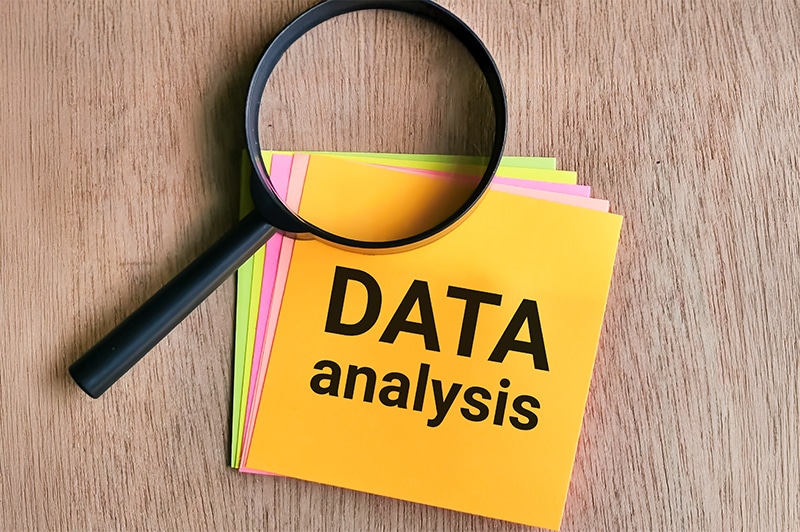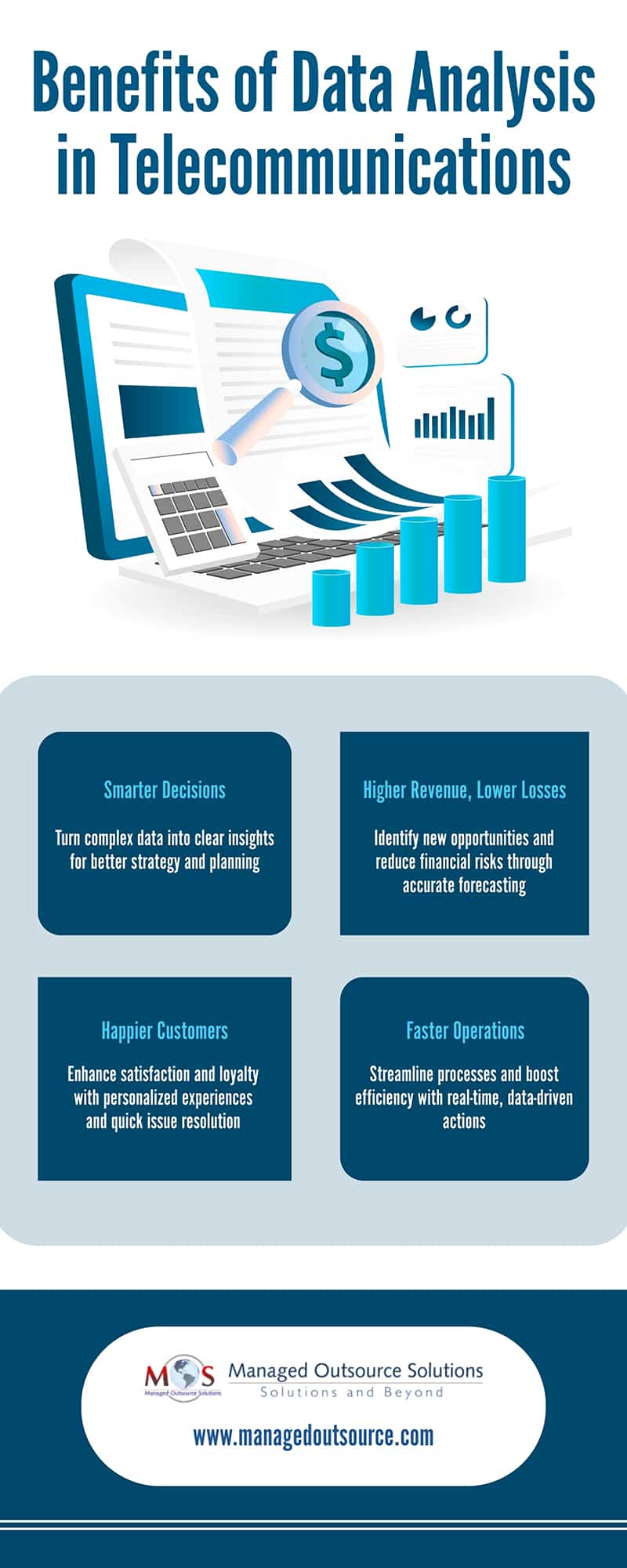The telecommunications sector is experiencing explosive growth, driven by digital transformation, the development of new technologies, high-speed internet, 5-G networks, and proliferation of connected devices. The sector is seeing unprecedented data growth as a result of these trends, making data analysis essential.
Supported by data mining, data cleansing and data conversion services, telecom analytics turns vast amounts of network and customer data into actionable insights, enabling faster, smarter decisions, optimized resource allocation, and enhanced service quality.
What is Data Analysis in Telecommunications?
Data analysis in the telecom context involves examining large datasets relating to customer usage, network operations, and billing to identify patterns, and gain insights. This analysis enables informed decision making to improve services, customer experiences, and profitability. By collecting, cleaning, transforming, and interpreting data, telecom companies can uncover trends, such as subscriber usage, fraud, network efficiency issues, and customer attrition, allowing them to optimize their services, manage networks, and develop new revenue streams.
Data analysis in telecommunication uses techniques like descriptive, diagnostic, predictive, and prescriptive analysis to extract insights from different types of telecom data such as call detail records (CDRs), network data, customer usage, billing data.
Call record analysis: Analyzing CDRs involves extracting data from call and data session records. Large volumes of call record data identifies patterns in call duration, frequency, location, and network usage.
This information is used to improve service quality, optimize costs, guide marketing strategies, and ensure accurate revenue collection. Unusual patterns in CDRs can also help detect potential fraud.
Network data analysis: Analyzing call drop rates and network issues in specific areas helps detect technical problems and initiate corrective actions. Identifying peak usage times helps in capacity planning and optimizing network performance.
Customer usage analysis: Understanding how customers use services helps in customizing offerings and improving user satisfaction. Identifying popular services or products can help marketing efforts and the development of new services.
Telecom Analytics Techniques and Tools
Data analysis in telecommunications relies on several advanced tools and technologies.
- Big data systems handle and store the huge amounts of information generated by telecom networks.
- Data mining services help discovering patterns in large datasets, which is crucial for understanding subscriber behavior and identifying valuable insights.
- Data visualization tools help interpret this data, track network performance, and guide better decision-making.
- Machine Learning (ML) and Artificial Intelligence (AI) powered tools used to create smart models for tasks like detecting fraud, managing network resources, segmenting customers, and offering personalized services.
- Supervised ML models also predict customer churn—identifying which users might leave—so telecom companies can take action to retain them and prevent revenue loss.
Key Applications of Data Analysis in Telecommunications
Data analysis plays a crucial role in helping telecom companies improve operations, enhance customer experiences, and make smarter business decisions. Some of the most important applications include:
- Network Optimization
Telecom networks generate massive amounts of data every second. By analyzing this data, operators can identify congestion points, predict network failures, and optimize bandwidth usage. This ensures smoother connections and fewer dropped calls for customers.
- Fraud Detection and Prevention
With millions of daily transactions, telecom fraud is a serious concern. Data analysis tools powered by machine learning can detect unusual patterns—such as sudden spikes in call activity or data usage—and flag potential fraud in real time.
- Customer Experience Management
By analyzing call records, service usage, and feedback data, telecom providers can understand customer behavior and preferences. This allows them to personalize plans, improve support services, and enhance overall satisfaction.
- Predicting Customer Churn
Losing customers can greatly affect a company’s revenue. Using predictive analytics, telecom companies can identify early warning signs—like reduced usage or complaints—and proactively reach out with offers or better services to retain customers.
- Revenue Growth and Marketing Insights
Data-driven insights help telecom businesses design targeted marketing campaigns. For example, by predicting customer preferences and purchasing behavior, telecom providers can launch tailored offers and promotions to the right audience at the right time. This leads to better conversions and sustainable revenue growth.
- Resource Planning and Forecasting
Analytics helps providers predict future network demand based on usage trends. This enables smarter investments in infrastructure and ensures consistent service quality even as demand grows.
Benefits of Telecom Analytics
Data analysis offers multiple benefits for the telecommunications industry, driving growth and efficiency at every level. It enables smarter decision-making by turning massive data volumes into actionable insights for better strategy and planning. Telecom providers can grow revenue and reduce losses through accurate forecasting, optimized pricing, and timely detection of inefficiencies. By understanding customer behavior and preferences, they can offer personalized services and faster issue resolution, enhancing user satisfaction and loyalty. Data-driven insights also help streamline operations, allowing telecom companies to make quicker, more informed decisions and maintain a competitive edge in a fast-evolving market.
Challenges and Considerations
Despite its many advantages, the use of data analysis in telecommunications comes with several challenges.
Data privacy and security are major concerns, as telecom companies handle sensitive customer information that must be protected from breaches and unauthorized access. Managing and processing the large volumes of data generated daily by networks, devices, and users also requires advanced infrastructure and scalable storage solutions.
Today, AI in telecommunication is transforming the industry by enabling real-time network monitoring, predictive maintenance, personalized customer experiences, and smarter decision-making through data-driven insights. However, integrating legacy systems with modern analytics tools can be complex and time-consuming due to outdated technologies and incompatible formats.
Finally, the industry faces a growing need for a skilled workforce and advanced technologies to effectively implement analytics solutions, interpret insights, and maintain data-driven operations.
Improving Telecom Operations using Data Analytics: The Right Support Matters
Advanced solutions can help telecom companies overcome these challenges by providing the expertise, technology, and scalability needed to manage complex data environments.
Outsourcing companies can handle and process large volumes of telecom data efficiently, using big data tools and AI-driven automation for faster, more accurate insights. They are equipped with advanced analytics platforms and secure cloud infrastructure, ensuring strong data privacy and compliance, reducing the risk of breaches.
By ensuring seamless integration between legacy systems and modern analytics tools, AI-driven solutions operate without disrupting existing operations. Moreover, partnering with these experts offers telecom companies access to a skilled analytics workforce without the cost and effort of in-house hiring, enabling them to focus on core business goals while leveraging the latest innovations in data analysis and reporting.
Benefit from the latest tools and technologies for faster data analysis and smarter decision-making.





